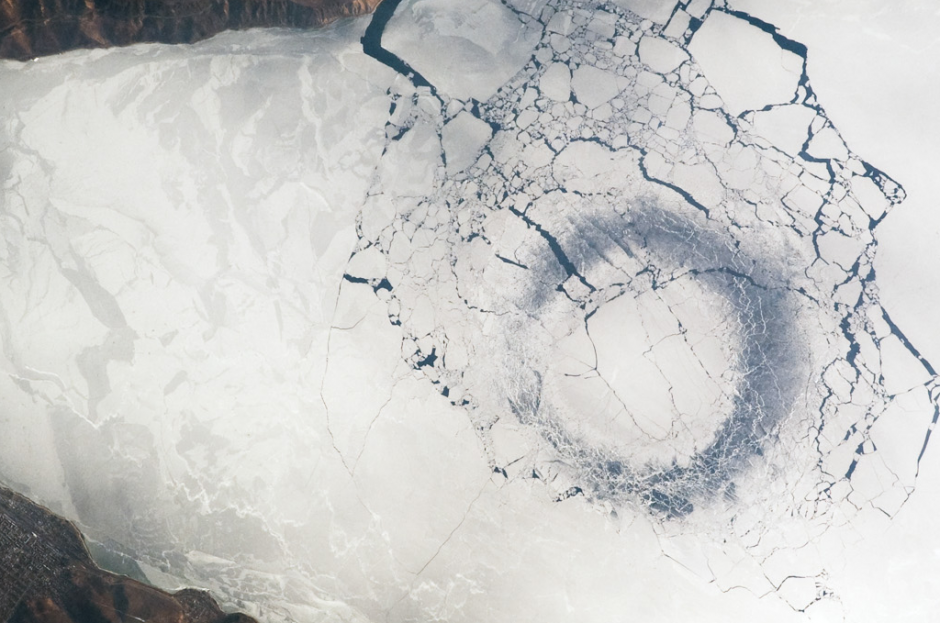Lake Baikal Ice Circles Prove Hard To Explain

-Lake Baikal, April 2009. (Credit: NASA / Public Domain)
Beginning in the 1990s, satellites have captured images of massive ice circles in Lake Baikal. The circles are so large that they can only be viewed by satellite in some cases, as the formations can stretch nearly 3 miles across.
The Lake Baikal ice circles don’t appear every year, but they have occurred frequently enough that scientists are attempting to figure out what is causing them. According to Scanex, a Russian satellite monitoring company, the rings have appeared in 2003, 2005, 2008, 2009, 2011, 2013 and 2014.
The fact that the ice circles don’t take place on a regular schedule has complicated pinpointing their cause. But that has not stopped many from guessing.
“While the origin of the circles is unknown, the peculiar pattern suggests convection (upwelling) in the lake’s water column,” reads a release from NASA in April 2009. “Ice cover changes rapidly at this time of year. Within a day, the ice can melt almost completely and freeze again overnight.”
Some say that the lake’s methane emissions are to blame, whereas others posit that there could be some underground source of heat pulsing up from the bottom. The heat explanation doesn’t hold a lot of weight, as there’s no known volcano near or under Lake Baikal. But it probably shouldn’t be ruled out entirely, as there are warm springs under the lake and, as a rift lake, Lake Baikal’s formation is associated with tectonic activity.
In a statement (in Russian), researchers from Scanex lay out another possibility: anticyclonic eddies. These are essentially swirling masses of water that investigators say come about thanks to the peculiarities of Lake Baikal’s circulation, underwater topography and coastlines.
In a video on the phenomenon, other scientists say that the ice circles may just be a sign of Lake Baikal’s age. Over time, they note the huge store of sediments it’s built up that may be adding to its gas emissions.
“This is the oldest, deepest lake in the world. This means it has a huge amount of sediment,” said Alan Lester, geologist at University of Colorado — Boulder, in the video. “It has incredibly thick layers of sediment in its bottom — upwards of 7 kilometers’ thick of sediment, as compared to maybe a few tens of meters of sediment in a typical lake.”
What do you think is causing the Lake Baikal ice circles? Which theory seems most likely to you? Please consider leaving a comment to share your thoughts!




Matthew Mabey
October 10, 2016 at 3:13 pm
I would like some clarification of this statement: “upwards of 7 kilometers’ thick of sediment, as compared to maybe a few tens of meters of sediment in a typical lake.”
Given the five main mechanisms for the formation of a natural lake (tectonics, volcanism, glaciation, karst, and landslide) I’m not clear that apples are being compared to apples. Many tectonic lakes have very large sedimentary columns filling the basins that the lake occupies. Tens of meters would not be typical for this type of lake and kilometers of sediment is not uncommon. The Dead Sea is a famous example and has ~8 kilometers of sediment under it. What was the point that the quoted statement was trying to make?
Daniel Kelly
October 11, 2016 at 2:05 pm
Hi Matthew, thanks for your comment. I believe the researcher was comparing Lake Baikal’s sediments to those of more common lakes. In the video we link to, they’re talking about how Baikal is different from the Great Lakes which aren’t typical lakes. But I think the idea overall was just to show how much sediment Lake Baikal has compared to average freshwater lakes.